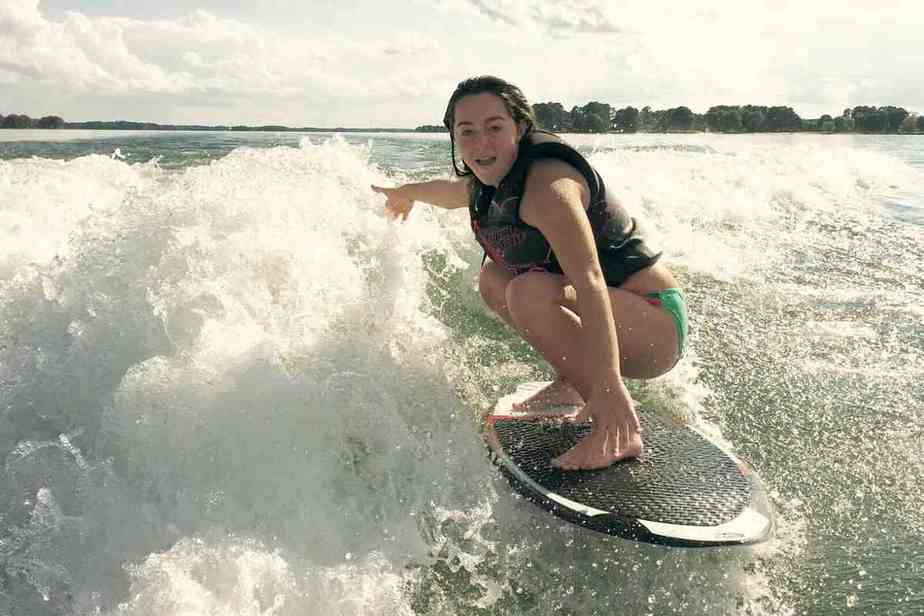Can I Wakesurf With Ballast? 3 Ways to Add It
Wakesurfers everywhere are chasing the perfect wake and doing whatever they can to create it.
When it comes to creating a great wake for surfing, there are a lot of questions about the best way to do it and how to efficiently weight your boat to create the wake you want to surf.
Sure, there’s a lot of information online and if you ask anyone who’s added ballast to their boat they would probably be thrilled to tell you everything they know.
Some of the information may be great, while other information may lead you farther from a good answer to your questions about adding ballast and wakesurfing with ballast.
I’ve had experience using ballast in my boat and have taken the time to research methods of adding ballast and how to get the best wake shape for wakesurfing.
Can I Wakesurf With Ballast? 3 Ways to Add It
Can you wakesurf with ballast? Absolutely! Adding ballast can help you create a better wakesurfing wake.
Wakesurfing has taken the water sports world by storm for about the last decade and may have even taken the spot of the most popular watersport. Looking around any lake during boating season, you’re sure to see at least a few groups using their boat to wakesurf.
Boat manufacturers are building boats with wakesurf technology already built-in, and there are tons of options for boards and other accessories to optimize your days on the water. But how do you create the perfect wake?
In short, adding ballast will go a long way in creating a bigger wake, but there is more to it than that. Let’s go over what ballast is, how to use it, and a few recommendations.
What is Ballast?
Ballast is used in a variety of industries, including aviation, car racing, and boating. In each industry, the idea and purpose of ballast is generally the same – to add weight for increased stability.
Ballast in its most simple definition is another word for weight, and is more specifically defined as, “heavy material, such as gravel, sand, or lead, placed low in a vessel to improve its stability.”
Ballast has a long history in the maritime industry dating back at least a couple hundred years to cargo ships transporting goods from Europe to America. As the cargo was loaded on the deck, the ships would become more top-heavy and less stable.
During a journey across the ocean, a less stable ship could be disastrous if the wind or waves got too intense; ships would be susceptible to capsizing putting everyone, and everything, on board in danger.
Goods needed to be transported, so captains had to figure out how to counteract the weight of the cargo so they could safely make their journey.
To do this, they began adding weight if various forms below deck. The weight at the bottom of the hull would act as a counterbalance for what was on the deck. Most of the ballast would need to be placed below the waterline for the maximum benefit.
Early sailors would use heavy cargo as ballast including stone, sand, and gravel. They would also add ballast tanks that could hold water and could be filled or emptied depending on the current need.
Ballast is still used today, though the systems have become more advanced. Ships and sailboats will often use a dense material such as lead, concrete, or iron to either construct or fill the keel of the vessel.
The heaviest part of the keel will be at the very bottom to help with the weight distribution.
Ballast tanks are still used and the systems available today allow for various compartments and the ability to pump water to the exact area you need it for maximum stability.
While stability is the main purpose of adding ballast to a boat, there is a desirable byproduct for wakesurfing.
Water cannot be compressed and, therefore, has to move out of the way to accommodate an object entering the water. A heavier object will require more water to be moved, or displaced, to create room for the object.
Then, as the object moves through the water, a wake will be created as the water moves around the object and then rushes back together when the object has passed (larger wake for a heavier object, smaller wake for a lighter object).
This means that when a boat moves through the water a wake is produced, and when weight is added to the boat a larger wake will be produced.

Using Ballast for Wakesurfing
There are two main components to an excellent wakesurfing wake – size and shape. Size without shape or shape without size could be okay, but you are likely missing out on surfing the best quality wake.
Wakesurfers are after a big wake that will provide the maximum amount of push for a rider and with ballast in the right places, it is possible to get a big, well-shaped wake.
The idea behind wakesurfing is to ride without holding onto a rope. To do this, the wake has to produce enough energy to push the rider along, keeping them in front of the wake and behind the boat.
Most boats do not have enough weight in the rear to create a wake with enough energy to push a rider, so ballast has to be added. Where the ballast is placed in the boat will directly impact the size and shape of the wake.
You’ll start by adding ballast to the rear corner of the boat on the same side the rider will be. This will create a tall wake that will have enough energy, or push, to keep the rider in the right position.
By only putting ballast in the rear, however, the wake will be tall, but won’t extend far behind the back of the boat; there won’t be a lot of room to ride.
If you also add some ballast in the bow, you will keep the tall wake created by the rear ballast, but the wake will end up being longer and will provide a better riding experience.
It is a fine balance of how much ballast needs to be added in the back and front of the boat – too much in the front and the wake won’t be tall enough, too much in the back and the wake won’t be long enough.
Every boat is different and there isn’t a universal formula for determining how much ballast to put where. Play around with the configuration on your boat to find the right setup for you.
How to Add Ballast
Some boats come from the factory with integrated ballast systems and have permanent tanks in the hull and water pumps to fill and drain the tanks.
If your boat doesn’t have an integrated ballast system, there are still ways to add portable ballast to get the perfect wake.
Water filled ballast bags might be the most popular portable ballast system available. Companies like FATSAC and Free Motion make portable ballast bags to meet almost any need.
They make bags to fit direct-drive and vee drive boats with various dimensions and weight capacities to give you flexibility as to where in the boat your ballast is and how much weight is added.
To use these bags, put them in the boat where you want them, then fill them with water up to the recommended limit. The great thing about water-filled ballast bags is they are easy to transport since they are only filled once you are on the water.
However, if you wanted to move the weight from one side of the boat to the other, it would require draining the bag before moving it. Still a great option if you want to add a lot of weight.
Another type of ballast bag available is a bag filled with steel shot or sand. These bags are typically made of a canvas or nylon material and are filled with small steel pellets or sand to make them a specific weight.
Steel shot bags are much smaller than water-filled ballast bags and range in weight from 5 lbs. to 50 lbs.
They are often used to add weight to small areas where a larger ballast bag won’t fit. They are also used to fine-tune the shape of a wake once the size is exactly where you want it.
While they won’t add as much weight as a water-filled bag, if they are in the right location, they will still make an impact on the size and shape of the wake your boat makes.
People can also be used as ballast. Even if you do have other ballast in the boat, people can be used to balance things out or as additional ballast in specific locations.
For instance, if you have a ballast bag in the rear creating a tall wake, but nothing in the bow, you can put one or two people in the front of the boat to help create a longer wake.
This can get a little tricky if you are trying to use people as the bulk of your ballast because getting enough weight in a specific location might be impossible unless people were stacked on top of one another.

Final Thoughts
Wakesurfing without ballast may be possible depending on your boat and how it is set up, but for a lot of people, adding ballast may be the only way to create a wake tall enough to get the right amount of push to be able to ride the wake.
There are plenty of options for adding ballast with a combination of a few options probably being the most efficient way – using water-filled ballast bags for the bulk of the ballast, then some smaller steel shot or sandbags for the smaller areas.
However you choose to add ballast, the result should be a tall well-shaped wake.



